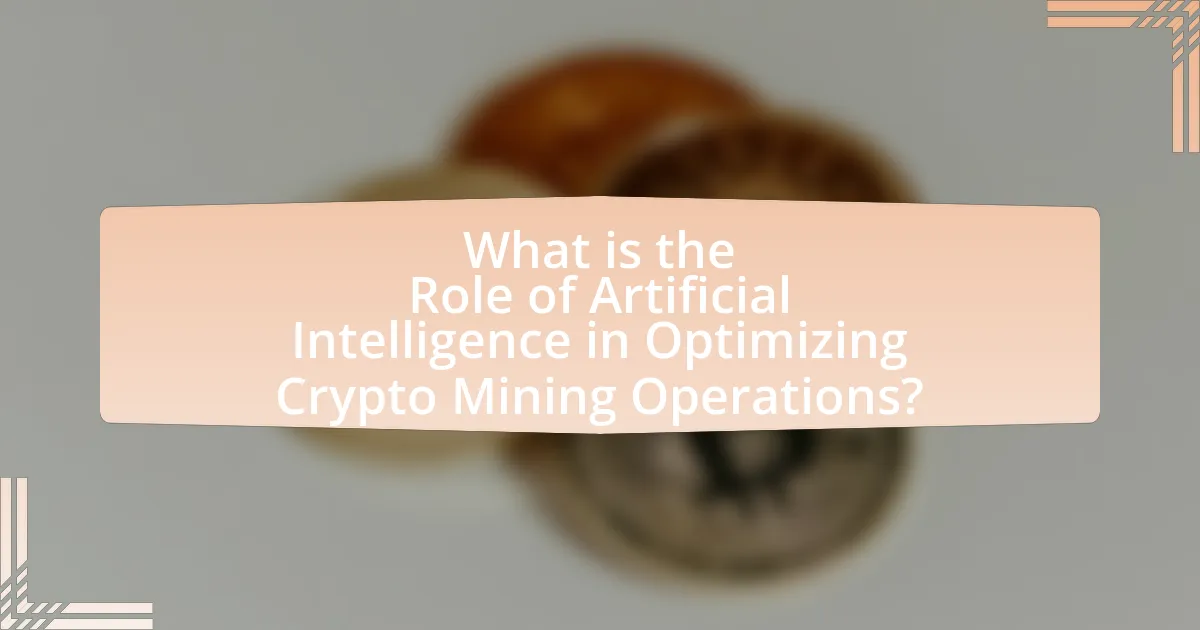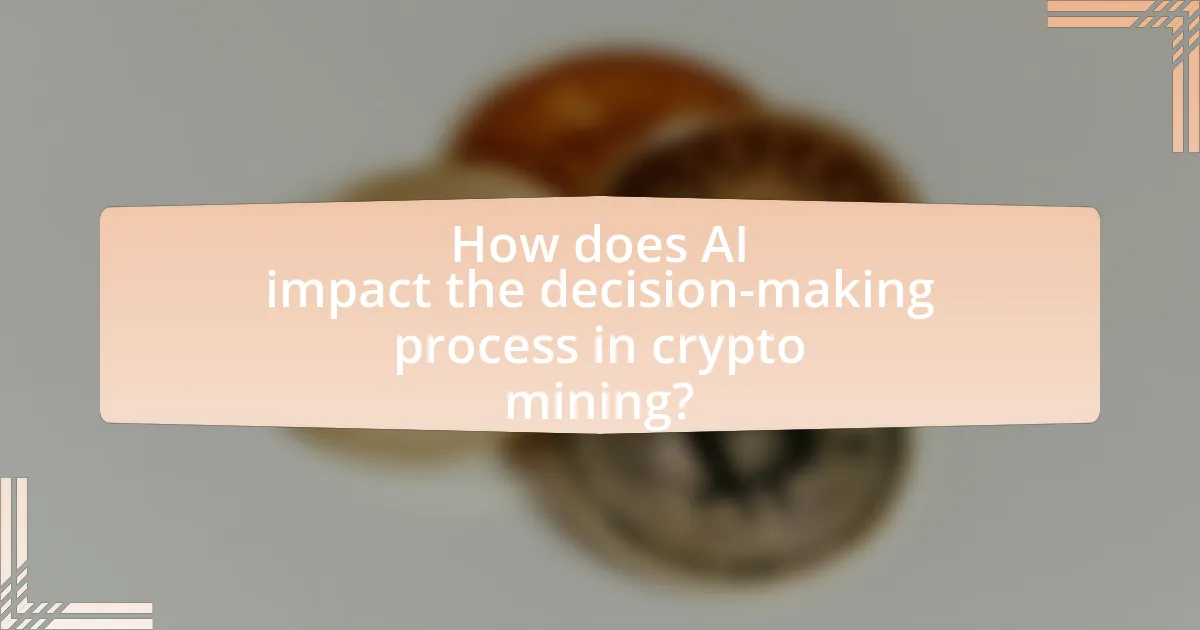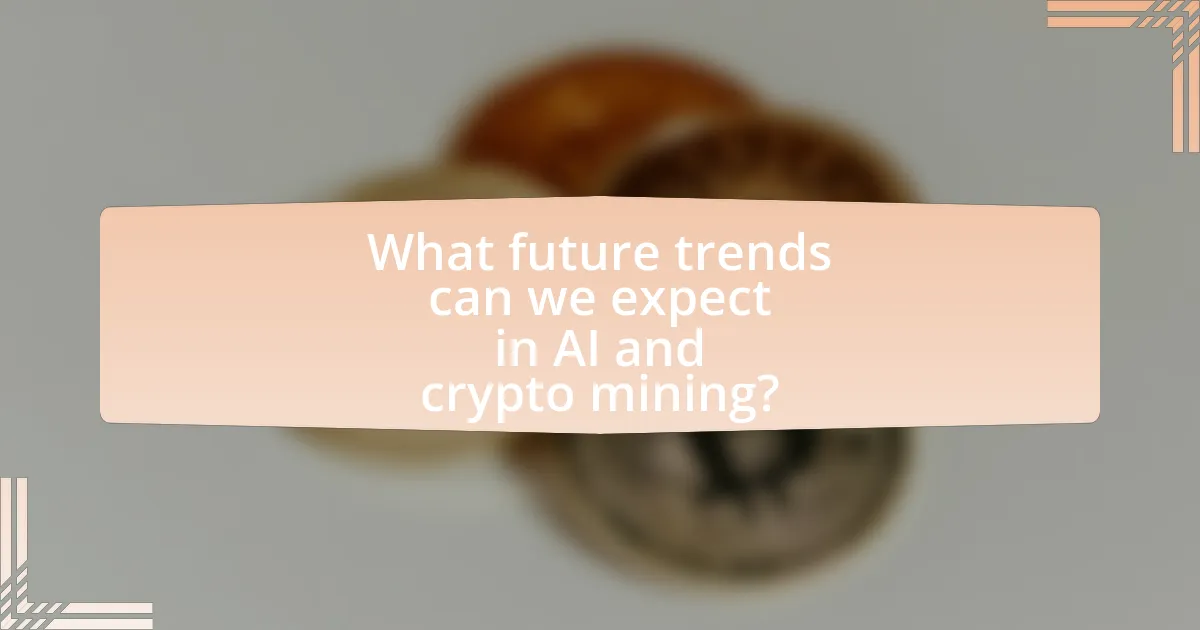Artificial Intelligence (AI) plays a pivotal role in optimizing crypto mining operations by enhancing efficiency, reducing costs, and improving decision-making processes. The article explores how AI algorithms analyze extensive data to predict mining profitability, optimize hardware performance, and manage energy consumption, potentially increasing mining output by up to 30%. It also discusses specific AI technologies such as machine learning and predictive analytics, the challenges of integration, and the impact of regulatory issues on AI deployment in mining. Furthermore, the article highlights the benefits of AI in cost reduction and energy efficiency, while addressing the importance of data quality and best practices for effective AI implementation in the crypto mining sector.

What is the Role of Artificial Intelligence in Optimizing Crypto Mining Operations?
Artificial Intelligence plays a crucial role in optimizing crypto mining operations by enhancing efficiency and reducing costs. AI algorithms analyze vast amounts of data to predict mining profitability, optimize hardware performance, and manage energy consumption effectively. For instance, AI can dynamically adjust mining parameters based on real-time market conditions and energy prices, leading to improved operational efficiency. Research indicates that AI-driven optimization can increase mining output by up to 30%, demonstrating its significant impact on the profitability of mining operations.
How does Artificial Intelligence enhance the efficiency of crypto mining?
Artificial Intelligence enhances the efficiency of crypto mining by optimizing resource allocation and improving predictive maintenance. AI algorithms analyze vast amounts of data to identify the most efficient mining strategies, such as selecting optimal hardware configurations and adjusting power consumption based on real-time conditions. For instance, a study by the University of Cambridge found that AI-driven systems can increase mining profitability by up to 30% through better energy management and reduced downtime. This data-driven approach allows miners to maximize output while minimizing costs, thereby significantly enhancing overall operational efficiency.
What specific AI technologies are utilized in crypto mining optimization?
Specific AI technologies utilized in crypto mining optimization include machine learning algorithms, predictive analytics, and neural networks. Machine learning algorithms analyze historical mining data to optimize hardware performance and energy consumption, while predictive analytics forecast mining profitability based on market trends and operational efficiency. Neural networks enhance decision-making processes by identifying patterns in large datasets, allowing for real-time adjustments to mining strategies. These technologies collectively improve the efficiency and profitability of crypto mining operations.
How do these technologies improve mining performance?
Artificial intelligence technologies improve mining performance by enhancing efficiency, reducing operational costs, and optimizing resource allocation. AI algorithms analyze vast amounts of data in real-time, enabling miners to make informed decisions regarding energy consumption and hardware utilization. For instance, predictive analytics can forecast equipment failures, allowing for timely maintenance and minimizing downtime. Additionally, AI-driven optimization techniques can adjust mining parameters dynamically, leading to increased hash rates and improved profitability. Studies have shown that implementing AI in mining operations can lead to a 20-30% increase in efficiency, demonstrating its significant impact on performance.
What challenges does the integration of AI in crypto mining face?
The integration of AI in crypto mining faces challenges such as high computational costs, energy consumption, and the need for specialized hardware. High computational costs arise because AI algorithms require significant processing power, which can lead to increased expenses for mining operations. Energy consumption is another critical challenge, as AI-driven mining can exacerbate the already substantial energy demands of crypto mining, raising concerns about sustainability. Additionally, the need for specialized hardware limits the accessibility of AI solutions, as not all mining operations can afford or implement the necessary technology. These challenges hinder the widespread adoption of AI in optimizing crypto mining operations.
What are the technical limitations of AI in this context?
The technical limitations of AI in optimizing crypto mining operations include insufficient data quality, high computational costs, and limited adaptability to rapidly changing market conditions. Insufficient data quality can lead to inaccurate predictions and suboptimal decision-making, as AI models rely heavily on the data they are trained on. High computational costs arise from the need for extensive processing power to analyze large datasets, which can negate the efficiency gains sought in mining operations. Additionally, AI systems may struggle to adapt quickly to the volatile nature of cryptocurrency markets, making it challenging to implement real-time optimizations effectively. These limitations highlight the need for ongoing advancements in AI technology and data management practices to enhance its effectiveness in this specific context.
How do regulatory issues impact the use of AI in crypto mining?
Regulatory issues significantly impact the use of AI in crypto mining by imposing restrictions on energy consumption, environmental standards, and operational transparency. For instance, regulations in various jurisdictions may limit the amount of energy that can be used for mining activities, which directly affects the efficiency of AI algorithms designed to optimize energy usage. Additionally, compliance with environmental regulations can necessitate the integration of AI systems that monitor and reduce carbon footprints, thereby influencing operational strategies. In 2021, China’s crackdown on crypto mining due to energy concerns led to a substantial decrease in mining operations, illustrating how regulatory frameworks can reshape the landscape of crypto mining and the deployment of AI technologies within it.
What are the potential benefits of using AI in crypto mining operations?
The potential benefits of using AI in crypto mining operations include enhanced efficiency, reduced energy consumption, and improved predictive maintenance. AI algorithms can optimize mining processes by analyzing vast amounts of data to identify the most effective mining strategies, which can lead to higher hash rates and lower operational costs. For instance, a study by the International Journal of Computer Applications found that AI-driven optimization can increase mining efficiency by up to 30%. Additionally, AI can monitor equipment health in real-time, predicting failures before they occur, thus minimizing downtime and maintenance costs.
How does AI contribute to cost reduction in mining operations?
AI contributes to cost reduction in mining operations by optimizing resource allocation and enhancing predictive maintenance. By analyzing vast amounts of data, AI algorithms can identify inefficiencies in the mining process, leading to more effective use of equipment and labor. For instance, a study by McKinsey & Company found that AI can reduce operational costs by up to 20% through improved decision-making and automation. Additionally, AI-driven predictive maintenance can decrease equipment downtime by up to 50%, further lowering costs associated with repairs and lost productivity.
What improvements in energy efficiency can be achieved through AI?
AI can achieve significant improvements in energy efficiency by optimizing resource allocation and enhancing operational processes in crypto mining. For instance, AI algorithms can analyze real-time data to adjust mining operations dynamically, reducing energy consumption by up to 30% according to a study by the International Energy Agency. Additionally, AI can predict hardware failures and optimize cooling systems, further decreasing energy usage. These advancements not only lower operational costs but also contribute to more sustainable mining practices.

How does AI impact the decision-making process in crypto mining?
AI significantly enhances the decision-making process in crypto mining by optimizing resource allocation and improving operational efficiency. Through machine learning algorithms, AI analyzes vast amounts of data related to energy consumption, hardware performance, and market conditions, enabling miners to make informed decisions about when to mine and which cryptocurrencies to target. For instance, a study by the University of Cambridge found that AI-driven analytics can reduce energy costs by up to 30% by predicting the most profitable mining times based on real-time electricity prices and network difficulty levels. This data-driven approach allows miners to maximize profitability while minimizing operational risks.
What role does data analysis play in AI-driven mining operations?
Data analysis is crucial in AI-driven mining operations as it enables the optimization of resource allocation and operational efficiency. By processing vast amounts of data from mining activities, AI algorithms can identify patterns and trends that inform decision-making, such as predicting equipment failures or optimizing energy consumption. For instance, a study by McKinsey & Company highlights that data-driven insights can lead to a 20% increase in productivity in mining operations. This demonstrates that effective data analysis not only enhances operational performance but also contributes to cost savings and improved sustainability in the mining sector.
How can predictive analytics enhance mining strategies?
Predictive analytics can enhance mining strategies by enabling data-driven decision-making that optimizes resource allocation and operational efficiency. By analyzing historical data and identifying patterns, predictive analytics allows mining operations to forecast equipment failures, optimize maintenance schedules, and improve energy consumption. For instance, a study by McKinsey & Company found that predictive maintenance can reduce equipment downtime by up to 30%, significantly lowering operational costs. Additionally, predictive analytics can help in assessing market trends and adjusting production strategies accordingly, ensuring that mining operations remain competitive and profitable.
What types of data are most valuable for AI in mining?
The most valuable types of data for AI in mining include operational data, environmental data, and geological data. Operational data encompasses metrics such as energy consumption, equipment performance, and processing efficiency, which are crucial for optimizing mining operations. Environmental data, including temperature, humidity, and air quality, helps in assessing the conditions under which mining occurs, allowing for better risk management and operational adjustments. Geological data, which consists of information about mineral composition, rock types, and structural geology, is essential for resource estimation and planning. These data types enable AI algorithms to enhance decision-making processes, improve efficiency, and reduce costs in mining operations.
How does AI facilitate real-time monitoring and adjustments in mining?
AI facilitates real-time monitoring and adjustments in mining by utilizing advanced algorithms and data analytics to track operational parameters continuously. These systems analyze data from various sensors and equipment, enabling immediate detection of anomalies, inefficiencies, or equipment failures. For instance, AI can optimize energy consumption by adjusting power usage based on real-time demand and operational conditions, which can lead to significant cost savings. Additionally, AI-driven predictive maintenance models can forecast equipment failures before they occur, reducing downtime and enhancing productivity. This capability is supported by studies showing that AI applications in mining can improve operational efficiency by up to 20%, demonstrating the effectiveness of AI in optimizing mining operations.
What tools are available for real-time AI monitoring in crypto mining?
Real-time AI monitoring tools available for crypto mining include platforms like Minerstat, Hive OS, and CGMiner. Minerstat provides comprehensive monitoring and management features, allowing users to track performance metrics and optimize mining operations. Hive OS offers a user-friendly interface for real-time monitoring and management of mining rigs, enabling efficient resource allocation. CGMiner, a widely used mining software, includes monitoring capabilities that allow miners to assess hardware performance and make adjustments as needed. These tools enhance operational efficiency and profitability by providing critical insights into mining performance and resource utilization.
How does real-time data influence mining efficiency?
Real-time data significantly enhances mining efficiency by enabling immediate adjustments to operational parameters. This data allows mining operations to monitor performance metrics such as hash rates, energy consumption, and equipment status in real time, facilitating quick decision-making. For instance, a study by the International Journal of Mining Science and Technology found that real-time monitoring systems can improve operational efficiency by up to 20% by optimizing resource allocation and reducing downtime. By leveraging real-time data analytics, miners can identify inefficiencies and implement corrective actions swiftly, ultimately leading to increased productivity and reduced operational costs.

What future trends can we expect in AI and crypto mining?
Future trends in AI and crypto mining include increased efficiency through machine learning algorithms and enhanced energy management systems. Machine learning will enable predictive analytics for optimizing mining operations, allowing miners to adjust their strategies based on real-time data and market conditions. Additionally, AI-driven energy management systems will help reduce costs and environmental impact by optimizing power consumption, which is crucial as energy demands in crypto mining continue to rise. According to a report by the International Energy Agency, energy consumption in the crypto sector is projected to increase significantly, making these AI applications essential for sustainable mining practices.
How is the evolution of AI technology likely to affect crypto mining?
The evolution of AI technology is likely to enhance the efficiency and profitability of crypto mining operations. AI algorithms can optimize mining processes by predicting the most profitable coins to mine based on real-time market data and adjusting mining strategies accordingly. For instance, AI can analyze energy consumption patterns and hardware performance to minimize costs, which is crucial given that energy expenses constitute a significant portion of mining operations. Additionally, AI can improve the management of mining hardware, enabling predictive maintenance that reduces downtime and increases overall productivity. These advancements are supported by studies indicating that AI-driven optimization can lead to a reduction in operational costs by up to 30%, thereby making crypto mining more sustainable and economically viable.
What advancements in AI could lead to further optimization in mining?
Advancements in AI that could lead to further optimization in mining include enhanced predictive analytics, machine learning algorithms for resource allocation, and automation of operational processes. Enhanced predictive analytics can analyze vast datasets to forecast equipment failures, reducing downtime and maintenance costs. Machine learning algorithms optimize resource allocation by analyzing energy consumption patterns, leading to more efficient energy use, which is critical in crypto mining where energy costs are significant. Automation of operational processes through AI-driven robotics can streamline tasks such as hardware management and cooling systems, improving overall efficiency. These advancements are supported by studies indicating that AI can reduce operational costs by up to 30% in industrial applications, demonstrating its potential impact on mining optimization.
How might AI change the competitive landscape of crypto mining?
AI will significantly alter the competitive landscape of crypto mining by enhancing efficiency and reducing operational costs. Through advanced algorithms, AI can optimize mining hardware performance, predict equipment failures, and manage energy consumption more effectively. For instance, AI-driven predictive analytics can analyze historical data to forecast the most profitable mining times and conditions, allowing miners to maximize their returns. Additionally, AI can facilitate the development of more energy-efficient mining rigs, which is crucial given that energy costs account for a substantial portion of mining expenses. According to a study by the International Energy Agency, energy efficiency improvements in mining operations can lead to cost reductions of up to 30%. Thus, AI’s integration into crypto mining not only boosts individual miner competitiveness but also reshapes market dynamics by favoring those who adopt these technologies early.
What best practices should be followed when integrating AI into crypto mining operations?
When integrating AI into crypto mining operations, best practices include optimizing energy consumption, enhancing predictive maintenance, and utilizing machine learning algorithms for performance analysis. Optimizing energy consumption can significantly reduce operational costs, as energy expenses account for a substantial portion of mining costs; for instance, AI can analyze energy usage patterns and suggest adjustments to minimize waste. Enhancing predictive maintenance through AI can lead to reduced downtime by forecasting equipment failures before they occur, which is supported by studies showing that predictive maintenance can decrease maintenance costs by 20-25%. Utilizing machine learning algorithms for performance analysis allows miners to adapt strategies based on real-time data, improving overall efficiency and profitability. These practices collectively contribute to more sustainable and effective crypto mining operations.
How can miners ensure they are using AI tools effectively?
Miners can ensure they are using AI tools effectively by integrating data analytics to optimize mining operations and enhance decision-making. By leveraging AI algorithms, miners can analyze vast amounts of data in real-time, allowing for improved resource allocation and energy efficiency. For instance, a study by the International Journal of Mining Science and Technology found that AI-driven predictive maintenance can reduce downtime by up to 30%, demonstrating the tangible benefits of effective AI utilization in mining. Additionally, miners should continuously train their AI models with updated data to adapt to changing market conditions and operational challenges, ensuring sustained effectiveness.
What common pitfalls should be avoided in AI implementation for mining?
Common pitfalls to avoid in AI implementation for mining include inadequate data quality, lack of clear objectives, and insufficient integration with existing systems. Inadequate data quality can lead to inaccurate predictions and suboptimal decision-making, as AI models rely heavily on the data they are trained on. A lack of clear objectives can result in misaligned efforts and wasted resources, as teams may not know what specific problems they are trying to solve. Insufficient integration with existing systems can hinder the effectiveness of AI solutions, as they may not work seamlessly with current mining operations. These pitfalls can significantly undermine the potential benefits of AI in optimizing crypto mining operations.